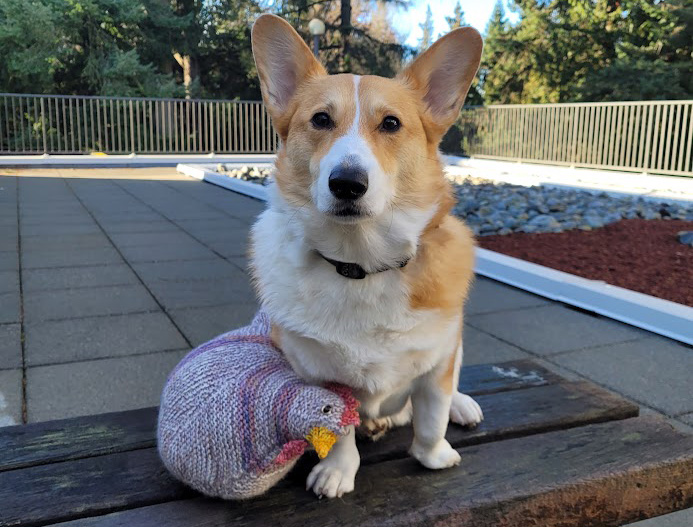Sally Wang regularly walks her corgi Pidan around campus on days when the dog accompanies her to work in Thea Koerner House on Crescent Road and West Mall. Recently, while walking along Marine Drive past the Nitobe Gardens, a coyote approached them from behind and tried to bite Pidan’s ample hindquarters.
Wang crouched down to protect her dog while shouting at the coyote. It was reluctant to move away.
It was only when a man who was walking past in the other direction also started shouting that the coyote backed off.
When Wang and Pidan resumed their walk, the coyote continued to follow them until they got to an area where there were more people.
Elle Black, who lives in Wesbrook and walks her dog all around campus, recently had what she described as a weird experience around Eagles Drive and East Mall. “I was walking next to the sports field and saw a couple across the street walking an elderly dog who was behind them.
“On a first glance I thought they had a second dog following them off leash, but then I did a double take and realized it was a coyote closely following the dog. The couple realized at that time and turned to yell at the coyote, and it stood there watching for a bit then crossed the street and then I left as I was with my own dog and worried it would follow us as well.”
In late May, Matthew Evenden was walking his dog on the lawn on East Mall, north of the Allard Law building when they were approached by a coyote. “I saw it coming, so lifted the dog and shouted at the coyote. It stopped but only departed when I made moves to come towards it.”
That same weekend, the UNA received two similar reports. A resident in Chancellor Place was out walking a dog and had to pick it up and run. Two residents intervened to try and scare the coyote away. The other incident occurred by the Theology Mall Lawn, near Chancellor Boulevard where a coyote approached a resident walking a dog and was “showing signs of aggression” toward the dog.
Black says that as the owner of a small dog, these encounters make her worried about walking in less populated areas on campus, and she’s not alone.
Coyotes are predators, and small dogs or cats are prey to them. While obviously residents worry about the threat to their beloved pets, these reported incidents don’t necessarily represent increased aggression by the coyotes.
Local blogger Charles Menzies, who wrote about coyotes in 2022, says, “I see coyotes every other day. None of them appear more aggressive than normal. Regularly, coyotes pass within 10 feet or so of me minding their own business.”
David Klonsky, another regular walker, agrees. He says he sees coyotes “all the time” but “I haven’t noticed different behaviour.”
Campus Safety and Security says there is no central or consistent monitoring of coyotes on campus. There is also no consistent collection of data about coyote numbers, activity or behaviour on campus. There are educational efforts to make people aware of co-existing with coyotes, as The Campus Resident reported in October 2023.

The lack of a central reporting authority means that people may report coyote interactions to B.C. Wildlife, the Stanley Park Ecological Society (SPES), the UNA, or some combination. At the UNA, Wegland Sit says the UNA passes reports it receives to SPES, but the UNA doesn’t track reporting numbers or other data.
Rose Wilkin, the urban wildlife programs coordinator at SPES, says there has been “an increase in reports from UBC campus in the past few months. However, it’s hard to say whether this is because of an increase in sightings overall or only an increase in people reporting.”
Increased awareness about the need to collect information may be helping to build a picture, but there is little information available, and without a baseline, it’s not possible to make inferences about trends.
According to Wilkin, “Several reports stated the person had heard about our coyote report line through resident newsletters in the UBC community. This could be an explanation for the increase. Some of the recent reports have described aggressive behaviour, but drawing a comparison to previous years is difficult given the difference in the amount of data.”
SPES is open to becoming more involved in monitoring coyotes on campus, and according to Wilkin, “If SPES were more involved, there would be more we could do to address the issues surrounding coyotes on campus.”
However, the society’s normal procedure is to work with community partners, and the lack of a clear central contact on campus means there is no one for it to reach out to. “Given the number of requests we have recently received from UBC residents for information and advice, it seems the services we offer our partner municipalities would be put to good use in the UBC community,” she said.
ROBYN STARKEY IS A WESBROOK PLACE RESIDENT AND A MEMBER OF THE CAMPUS RESIDENT NEWSPAPER EDITORIAL COMMITTEE.
